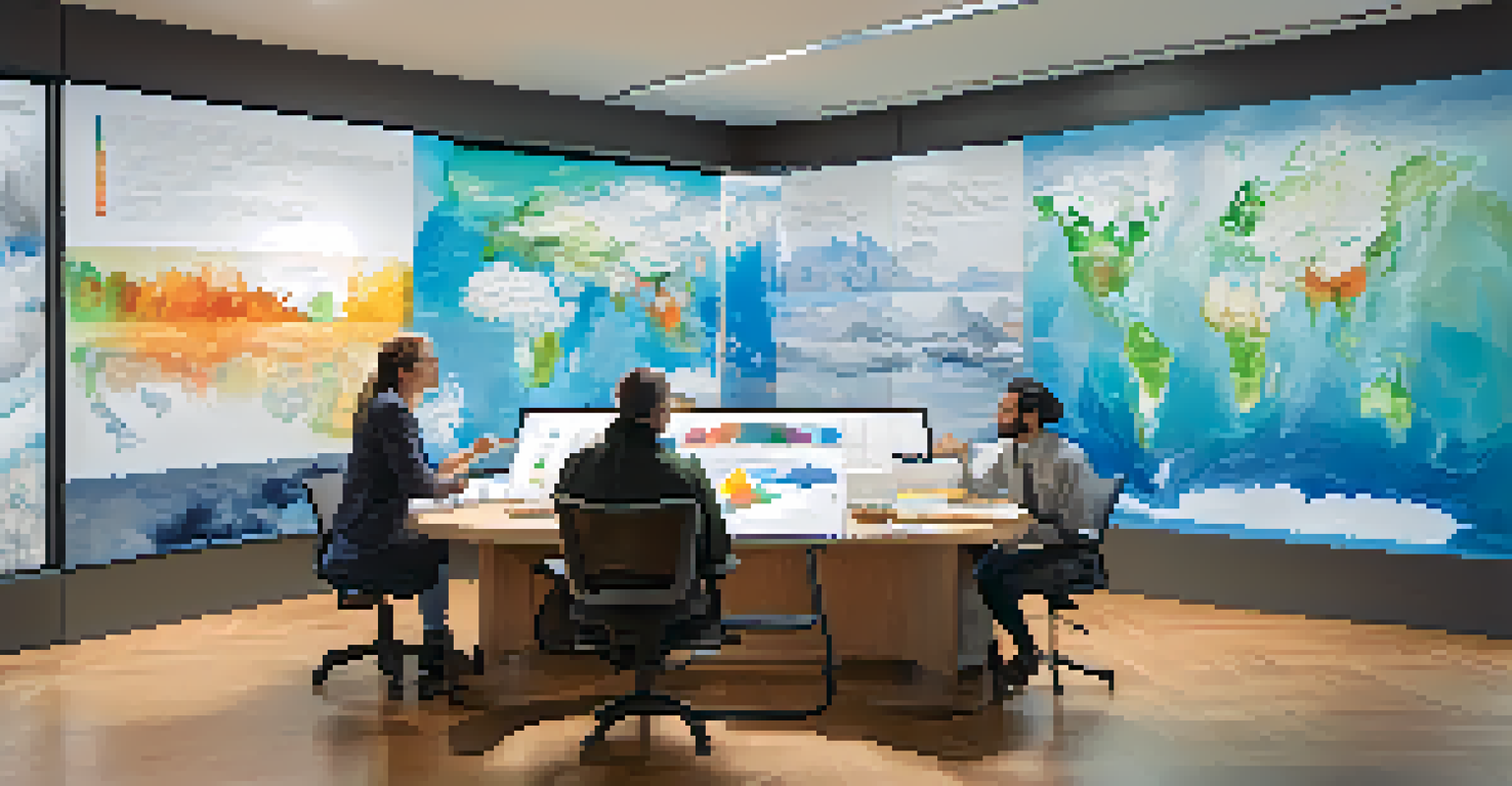Art in the Age of Climate Crisis: A Call to Action

The Role of Art in Addressing Climate Change
Art has always been a reflection of society, and in today's world, it plays a crucial role in addressing climate change. Through various forms, such as painting, sculpture, and performance, artists can capture the urgency of our environmental crisis. By engaging viewers emotionally, art can move people to understand and act on climate issues more deeply than statistics alone.
Art is not a mirror held up to reality, but a hammer with which to shape it.
For example, consider the powerful imagery in climate-related documentaries or the impactful installations that highlight rising sea levels. These artistic expressions not only inform but also provoke thought and discussion, making the abstract concept of climate change more tangible. They can create a sense of urgency that prompts individuals to reevaluate their own actions and beliefs.
Moreover, art can bridge gaps between communities, fostering collaboration and dialogue around climate solutions. It's a universal language that transcends cultural barriers, allowing people from diverse backgrounds to unite for a common cause. In this way, art not only raises awareness but also cultivates a sense of shared responsibility.
Art as a Tool for Environmental Advocacy
Artists have increasingly taken on the role of environmental advocates, using their platforms to promote sustainability and ecological awareness. By addressing issues like deforestation, pollution, and biodiversity loss, they highlight the urgent need for change. Their work can inspire activism and encourage viewers to participate in conservation efforts.

Take, for instance, the rise of eco-artists who incorporate recycled materials into their work. This not only raises awareness about waste but also challenges the traditional notions of art and value. The process of creating art from discarded items serves as a reminder of the potential for renewal and the importance of reducing our ecological footprint.
Art Engages Emotion for Climate Action
Through emotional engagement, art transforms complex climate issues into relatable narratives, inspiring individuals to take action.
Artistic initiatives often collaborate with environmental organizations, amplifying their message and reaching broader audiences. These partnerships can lead to community projects, public installations, and workshops that educate participants about sustainability. By merging art with advocacy, artists can effectively mobilize people towards environmental action.
The Impact of Art on Climate Awareness
Art has a unique ability to make complex environmental issues accessible and relatable. Through visual storytelling, artists can break down complicated scientific data into digestible narratives that resonate with the public. This approach not only educates but also encourages emotional engagement, making it easier for people to connect with the climate crisis.
The greatest threat to our planet is the belief that someone else will save it.
For example, a mural depicting the consequences of climate change can serve as a powerful visual reminder of what’s at stake. Such artworks often linger in our minds long after we’ve seen them, sparking conversations and inspiring personal reflection. This emotional connection can be a catalyst for change, prompting individuals to take action in their own lives.
Furthermore, art can create a sense of hope and possibility amidst despair. By showcasing innovative solutions and celebrating the beauty of nature, artists can inspire optimism and motivate communities to work towards a sustainable future. In this way, art becomes not just a form of expression but a vehicle for change.
The Intersection of Art and Science
In the fight against climate change, the collaboration between artists and scientists is increasingly important. This interdisciplinary approach allows for a more comprehensive understanding of environmental issues. Artists can visualize scientific data, making it more engaging and relatable for the general public.
For instance, artists have worked alongside climate scientists to create installations that illustrate the impact of global warming on polar ice caps. These projects not only educate viewers but also pose critical questions about our relationship with the planet. By blending artistic creativity with scientific rigor, these collaborations can lead to innovative solutions and heightened awareness.
Collaboration Fuels Environmental Advocacy
Artists working with scientists and communities amplify awareness and foster collective solutions to environmental challenges.
Additionally, art can serve as a medium for scientific communication, presenting research findings in a compelling manner. This can help bridge the gap between experts and the public, fostering a deeper appreciation for the complexities of climate science. Ultimately, the union of art and science can empower communities to engage with climate issues on multiple levels.
Community Engagement Through Artistic Projects
Community-based art projects have the power to unite individuals around common environmental goals. These initiatives often involve local residents in the creation process, fostering a sense of ownership and pride in their environment. By working together, communities can develop creative solutions to the challenges they face.
For example, a community garden project might incorporate art installations that raise awareness about local biodiversity. Residents can collaborate to design and implement these artworks, making the project a shared experience. This not only beautifies the space but also educates the community about sustainable practices and the importance of preserving local ecosystems.
Moreover, these projects can serve as a platform for dialogue, allowing community members to voice their concerns and aspirations regarding environmental issues. Art can create a safe space for discussion and reflection, empowering individuals to take action in their own neighborhoods. Through collective creativity, communities can inspire change and advocate for a sustainable future.
Art as a Catalyst for Policy Change
Art can also play a pivotal role in driving policy change by influencing public opinion and raising awareness about pressing environmental issues. Politicians and policymakers often respond to the sentiments expressed through artistic works, making art a tool for advocacy at the highest levels. By highlighting urgent climate challenges, artists can rally support for legislation and initiatives that promote sustainability.
For instance, art exhibitions focused on climate change have sparked discussions in legislative circles, prompting policymakers to consider new regulations. The visual and emotional impact of these artworks can be a powerful motivator for change, pushing environmental issues to the forefront of political agendas. This demonstrates how art can transcend the gallery walls and enter the realm of policy-making.
Art Influences Policy and Public Sentiment
By highlighting urgent climate issues, art can shape public opinion and drive policy changes toward sustainability.
Furthermore, art can serve as a reminder of the human stories behind climate data, adding a personal touch to often impersonal statistics. By sharing these narratives, artists can mobilize public support for effective climate action. Ultimately, art becomes a catalyst for change, encouraging decision-makers to prioritize environmental issues.
The Future of Art in the Climate Crisis
As we face an increasingly uncertain future due to climate change, the role of art will only become more critical. Artists will continue to push boundaries, exploring new mediums and methods to address environmental challenges. The intersection of technology and art will likely lead to innovative creations that engage audiences in unique ways.
Moreover, the growing awareness of sustainability within the art community will drive more artists to adopt eco-friendly practices. From using sustainable materials to reducing waste in their creative processes, artists have the potential to lead by example. This shift not only reflects a commitment to the planet but also inspires others to follow suit.

Ultimately, the future of art in the climate crisis is one of hope and resilience. As artists continue to inspire action and foster dialogue, they will play a vital role in shaping a more sustainable world. Art will remain a powerful medium for change, encouraging individuals and communities to rise to the challenge of protecting our planet.